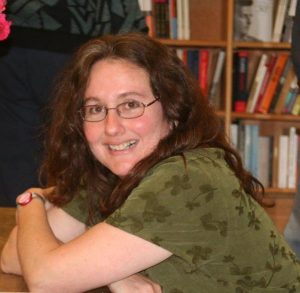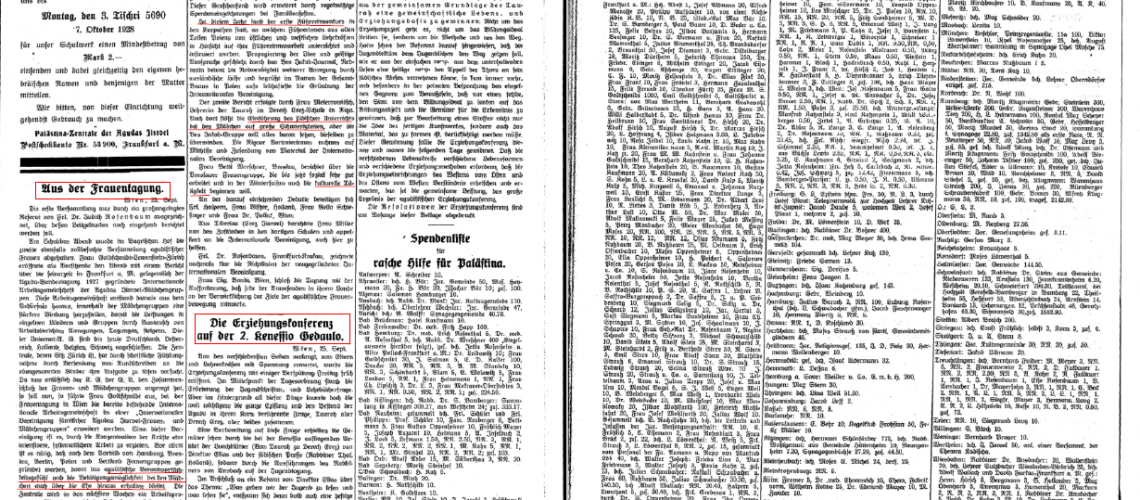Last week’s blog post translated Yiddish coverage of the founding of Neshei Agudath Israel in the Bais Yaakov Journal. This week, we present translation of German coverage from Der Israelit, a long-running newspaper founded by Rabbi Marcus Lehmann in the mid-nineteenth century. The article below appeared in the issue of September 26, 1929.
I’d like to credit Kalman Sporn for bringing this article to my attention, to Gershon Bacon, Michael Simonson for the preliminary translation, and the Leo Baeck Institute for the document.
Aus der Frauentagung
Vienna: September 25
The first meeting was enriched by a wide-ranging lecture by Dr. Judith Rosenbaum, the central theme of which will be discussed below.
After nightfall on the Shabbat, the second, well-attended gathering of Agudah women took place at the Bayerischer Hof [Hotel]. In her role as the chairwoman, Ms. [Franziska] Goldschmidt-Lewenstein from Zurich opened the evening with a report on the “International Working Committee of Agudah Girls’ Organizations,” which was established in 1927 Frankfurt am Main at the National Agudah Conference. This committee emerged out of the need for increased collaboration among girls’ organizations, to support activities within each of the countries and groups by exchanging reports, sharing practices, and convening conferences. At that point, only Germany, Austria, the Netherlands, Belgium and Switzerland were represented within the committee. The Central Office, based in Zurich, worked to accomplish its task by circulating reports and letters to this membership.
With the opportunity of the World Congress, the General Assembly of the Agudah declared its support for a gathering of women’s and girls’ groups; according to Mrs. Goldschmidt, the already existing international committee was now, at the Women’s Conference in Vienna, expanding to form a truly “International Association of Agudah Women.” The point of this expansion was to strengthen build on each other’s strengths. In particular, it was important to form women’s groups following the example of Hamburg, Breslau, Berlin, Poland and Latvia, which would strengthen women’s commitment to the Agudah and create opportunities for girls’ activities, even after they are married. The Central Office was committed to developing a working agenda, educational curriculum, and list of recommended reading in the next weeks and sending it out to all member groups.
The gathering was attended by unelected delegates of their respective countries (the Women’s Congress was organized at the last minute, for various reasons), but unanimously authorized by the General Assembly of the Agudath Israel, which officially recognized and enthusiastically greeted the “International Association of Agudah Women’s and Girls’ Organizations”.
Miss [Lotka] Szczarańska, a teacher at the Bais Yaakov Seminary in Kraków, spoke next, delivering an extensive report on the necessity, development and activities of the Bnos Agudath Israel in Poland, which works with exemplary discipline and passion. As of 1929 there are about a hundred Bnos groups with roughly 10,000 members, as well as some groups for Agudah women. The speaker described the achievements of the Bnos groups in the social sphere, including visits to the sick, volunteering for patients in non-Jewish hospitals, aid and support for new mothers, tutoring for children with learning difficulties, distributing food and clothing to impoverished Bais Yaakov pupils, and Tu Beshvat gifts of fruit to invalids, orphanages, and camps. They raise funds by strictly collecting small daily donations from each member, which works very well from a financial perspective. These small amounts are supplemented by periodic donations collected from families.
This past year, the first leadership program was held in the Carpathian Mountains. Young women from Bnos chapters all over Poland were instructed in leadership by teachers from both Eastern and Central Europe. The Bais Yaakov Journal helps spread the Bnos idea and enables intellectual exchange among participants. The report emphasized the need for further input from abroad, and in the name of the Bnos Organization of Poland, strongly supported the establishment of the international association.
The second report was delivered by Mrs. [Malka] Meierovitch, a teacher at the Torah and Derech Eretz School in Riga. There, too, founding Jewish schools for girls is very difficult, but the Bais Yaakov committees are doing their utmost to overcome all obstacles. Riga’s delegates are counting on help and material support from the International Association.
Mrs. Betti Wreschner from Breslau reported on the successful activities in the social realm of the women’s group in Breslau, and its intentions to expand its cultural activities this upcoming winter. Miss Halpern [possibly the ceramic artist Anna Halpern] and Miss Bisher from the Netherlands, and Mrs. Bella Schlesinger and Dr. Pollack from Vienna participated in the debate that followed.
In regards to the Land of Israel, Mrs. Miller reported on the conditions of the schools in Tiberias and called on the international association for assistance.
Dr. Rosenbaum from Frankfurt and Kraków again clearly highlighted the guidelines of the newly established International Association. Mrs. Bondi from Vienna brought the conference to a close with the invitation to all participants to work together to fulfill the aims of the Agudah’s women’s movement in each of their countries.

Naomi Seidman is the Chancellor Jackman Professor of the Arts in the Department for the Study of Religion at the University of Toronto and a 2016 Guggenheim Fellow; her 2019 book, Sarah Schenirer and the Bais Yaakov Movement: A Revolution in the Name of Tradition, explores the history of the movement in the interwar period.

